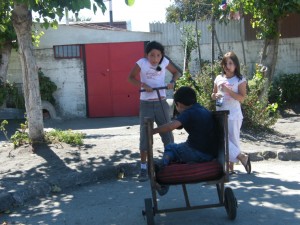
One year after the earthquake people join together in religious meetings across the country. Photo: ACT/Paul Jeffrey
This morning I woke and took fifteen minutes to think about the last year, its successes and challenges, moments to remember both good and bad, and the hopefulness found through it all. I think it is important that we all see ourselves as participants in this effort. Through the sharing of our gifted resources, taking moments in silence to pray in solidarity with those who continue to struggle in Haiti, sharing information and stories to one another to continue to build awareness on the issues facing Haiti, contributing your skills and expertise through volunteerism; all these contributions manifests a community participating in the renewal of hope and livelihoods in Haiti.
I can not put into words the overwhelming feeling of frustration and pain felt when conditions don’t seem to improve. While relief efforts were quick to respond to emergency needs, recovery efforts have been slow to start; housing is still a daily struggle for hundreds of thousands of families that are still displaced and living in camps. Yet, Haitian colleagues, who have themselves suffered loss, are dedicated to the work they do for their fellow citizens and continue to persevere with rebuilding efforts.
I see hopefulness in changes seen. Children have returned to school, signaling the strengthening of Haiti’s next generation of leadership and workers. People are back to work, earning a wage to provide for their families and beginning the work of rebuilding their own lives.
So, on this anniversary day, I want to extend gratitude for all the gifts that have been shared and challenge you to continue to find ways to contribute to the rebuilding of Haiti. Years of work remains ahead of us as Haiti continues to recover from the earthquake and addresses conditions of poverty.
I also invite each of you to hold a minute of silence to honor the victims of the 2010 earthquake at 4:34 pm (Haitian time), exactly one year from when the earthquake struck.
God’s Peace,
Megan

